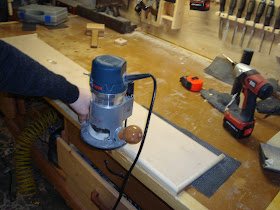We decide to go with a wall hanging cabinet to store them, and we want to put it in our guest bedroom. The trim in our house is white, and this room already has a white builtin, so I'll need to paint the new cabinet white so that it goes with the room.
I drew up a plan in sketchup to hold all the CDs we have and still give us some room for expansion.
Sketchup File
I choose some 3/4 inch "whitewood" plywood from Lowes and some poplar for the face frame and edging for the exposed plywood edges. After looking at this plywood, I think it's face veneer is poplar. I also bought a sheet of 1/4 inch plywood for the back.
Construction of this cabinet is pretty straighforward. I cut the plywood pieces to rough size with a circular saw and cutting guide, and then cut the final dimensions on the table saw.

The face frame pieces are just cut to final length and then attached to each other with a pocket hole screws. I make these with my pocket hole jig. It's not the strongest joint in the world, but it's quick and it's plenty strong for this application.
I cut biscuit slots into the front of the plywood shelves and the back of the face frame to help me align the pieces during glue up. This really turns out to help a lot, and I'd recommend you try it if you build any face frame cabinetry. Once these are done, I glue and clamp the face frame to the plywood case.
After gluing on the face frame, the middle and bottom shelves were left with the face frame slightly proud of the shelf surface. I trimmed the face frame closer with a block plane and chisel for the tighter areas, and then finally sanded it flush.
I fit some spacers in between the middle shelf and the top and bottom of the cabinet to keep the shelf from sagging. The middle shelf is also glued to the face frame which should discourage sagging as well.
The back of the plywood case has a deep rabbet all the way around to receive the 1/4 inch plywood back as well as a couple of cleats to beef up the cabinet at the mount points.
The header and footer are made from plywood with 1/2 inch poplar strips glued onto the edges. I ripped these strips out of the same material I made the face frame out of. I glued on the edging strips and used brads to hold them in place while the glue dried. Then I routed a roman ogee shape into the edging to dress up the cabinet a little.
The header and footer are glued onto the plywood case. The footer has some scrap 3/4 inch plywood spacers glued in between it and the bottom of the case to provide clearance for the bottom of the face frame.
I painted the cabinet with typical interior latex wall paint. After that was dry I put water bourne polyurethane over it to prevent blocking (latex paint staying tacky after dry). The water based poly did seem to check (crack) a little, so I'm not sure if its compatible with the latex or not. Or myabe I didn't give the latex long enough to dry out before I top coated it with the clear. I gave it at least overnight, but maybe I should have given it a couple days.
Here's the cabinet hung up and in use!
If you enjoyed this article, consider subscribing to our blog. We have email as well as rss/atom subscription options available at the top right of the page.























No comments:
Post a Comment